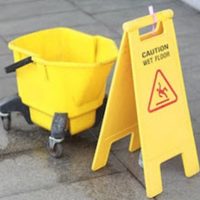The Role Of Constructive Knowledge In Slip And Fall Cases

When you are injured because of a dangerous condition on someone’s property, the property owner must know about the dangerous condition beforehand. After all, how can a property owner be expected to repair or clean or warn of a dangerous condition that the property owner didn’t actually know about?
On the other hand, if the victim had to show that a property owner actually knew of a dangerous condition, that would be almost impossible to prove. A store or business owner doesn’t always know that there is a spill, or something in a walking area that is dangerous. In fact, if actual knowledge was required for a victim to win a slip and fall case, a business owner could purposely ignore its property, in order to remain ignorant to any hazards or dangers.
Constructive Notice
That’s why the law allows a fall victim who is injured on someone else’s property to prove what is known as constructive notice. Think of constructive notice as “knowing without actually knowing.” Constructive notice says that a property owner knows of a dangerous condition, even if it doesn’t actually know.
If a property owner knows or should have known, in the exercise of due and diligent care, that there was a dangerous condition, the property owner can be held liable.
Time and Constructive Notice
As a general rule, a property owner doesn’t have to know about the condition of its property all the time, every second of the day. The law looks to see if the property owner was diligent in inspecting, cleaning and repairing its property, to see if the property owner had constructive notice of a dangerous condition.
Time is a big factor in determining constructive knowledge. The longer a dangerous condition exists on a business owner’s property, the more likely it is that the business owner “should have known” that the condition existed, and that it should have cleaned or repaired the condition.
How Long?
For example, if a gallon of milk spills on the floor, and sits there for an hour before someone falls on it, the store can be charged with constructive knowledge that the spill was there—a reasonably diligent and prudent business owner would inspect its property more than one time per hour.
It can be hard to prove how long a dangerous condition existed on a given property, but inferences can often help. For example, in our spilled milk example, if the milk had footprints in it, had spread out, and become dirty, it’s likely the milk was there for a longer period of time, proving constructive knowledge.
In some cases, proving the amount of time a dangerous condition existed isn’t necessary. For example, if the victim alleges that a store had inadequate security, that either existed or not. Constructive notice wouldn’t matter in those types of cases.
Call the Knoxville premises liability lawyers at Fox Farley Willis & Burnette, PLLC, today if you are injured in any kind of fall.
Sources:
uslawessentials.com/what-constructive-knowledge/
iirsm.org/news/what-constructive-knowledge
